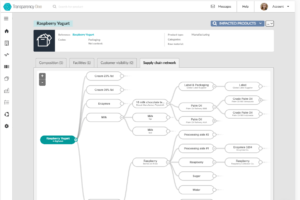The benefits of responsible sourcing are well known. Today, the question most organizations have is not why they should ensure sustainable and responsible sourcing, but how. What is the best approach to responsible sourcing?
Responsible sourcing is hardly one size fits all. According to Gartner, “there’s a variety of approaches to responsible sourcing which can make things confusing.” The “best” approach depends entirely on an organization’s size, industry, priorities, product range, supply chain model, and available resources, among many other factors. Some businesses, typically large organizations, are further along in their responsible sourcing journey, whereas others may be taking their first steps.
Gartner’s “Responsible Sourcing Scope Definition” provides an overview of the different approaches to responsible sourcing.
- At the base of the pyramid, the focus is on ensuring compliance with essential legal requirements. This is the fundamental foundation of responsible sourcing.
- At the top of the pyramid, the focus is on establishing long-term business viability by driving greater change throughout the extended supply chain. This is more ambitious than basic compliance but also provides more benefits.
Ultimately, the best approach to responsible sourcing is determined by an organization’s specific goals. We look at how a responsible sourcing program will differ depending on whether the focus is on legal compliance, supplier sustainability, or something in between.
Legal compliance
A compliance-centric approach aims to reduce risk and meet essential legal requirements. Compliance requirements are set by authoritative entities such as governments and can touch upon a wide range of topics including safety, sustainability, or human rights.
Typically, a compliance-first approach:
- Focuses on Tier 1 suppliers
- Has clearly defined requirements, as established by relevant entities or regulations
- Captures essential data in the form of audits, documents, simple questionnaires, or self-assessments
- Requires supplier participation, with strict consequences for failure to respond or comply (e.g. termination of business relationship)
- Can involve basic analytics, such as the organization’s level of overall compliance, supplier response rate, and supplier locations
A compliance-centric approach is essential to ensure products meet basic legal requirements. It is a necessary foundation upon which future and more involved responsible sourcing initiatives can be built.
Supplier sustainability
 Businesses aiming to establish long-term viability and brand differentiation through responsible sourcing require a different approach. These organizations have already met compliance requirements are ready to advance their responsible sourcing programs.
Businesses aiming to establish long-term viability and brand differentiation through responsible sourcing require a different approach. These organizations have already met compliance requirements are ready to advance their responsible sourcing programs.
For such businesses, the goal is to gain a more in-depth understanding of their suppliers to proactively reduce risk and increase supply chain sustainability. Increased knowledge of the extended supply chain will help organizations better understand their global impact and make necessary changes to ensure sustainable sourcing, for the long term.
Typically, a sustainability-focused approach:
- Requires data capture below Tier 1, possibly to the raw material level
- Involves significant pre-work to determine requirements. Before contacting suppliers and mapping supply chains, organizations must first discuss their goals internally and determine what specific data is needed to meet these goals. Unlike a compliance-based approach, it is not about meeting legal requirements, but rather contributing to the company’s strategic goals and commitments.
- Captures a wide variety and depth of supply chain data. Data can be in the form of audits, documents, and basic questionnaires, or involve much more detailed and lengthy assessments to capture extremely specific and/or detailed data.
- Allows for more flexible supplier participation. Supplier participation and compliance is still expected, but suppliers may be given more leeway due to the detailed and sometimes specialized nature of the data requested. A supplier’s inability to comply may kickstart a collaborative effort to help the supplier reach the desired goal.
- Involves more complex and detailed analytics. The analytics required for a sustainability-focused approach highly depends on the organization’s specific goals. Reports are typically more detailed and go beyond assessing basic compliance. For example, they may cross-reference existing supplier data with third-party information on global water stress or deforestation to highlight potential areas of long-term risk.
A sustainability-centric approach is undoubtedly more complex than basic compliance, but will lead to long-term benefits in terms of brand differentiation, risk reduction, and business viability.
Comparing different approaches to responsible sourcing
Below is an overview of how these two approaches to responsible sourcing—compliance-focused or sustainability-focused—compare. Keep in mind, however, that a wide range of approaches exists between these two extremes. Organizations may tailor their responsible sourcing programs to suit their specific priorities and abilities.
| Legal Compliance | Supplier Sustainability | |
| Scope | Typically Tier 1 | Tier 1+, possibly down to raw material level |
| Supplier Participation | Mandatory | Likely still mandatory, but more flexibility/opportunities for improvement |
| Consequences of non-compliance | Small period for suppliers to address issues—or end of contract | Greater allowance for suppliers to address issues. Greater likelihood of collaboration between buyer and supplier to help supplier meet buyer’s requirements |
| Requirements | Clearly defined by regulations, including frequency of data collection | Internal pre-work is required to determine what specific data is needed and how often it should be collected |
| Type of data needed | Audits, documents, basic questionnaires | May be the same as compliance, or require more specific/extensive questionnaires or assessments |
| Analytics | Basic analytics are sufficient to monitor progress. Examples include reports to assess supplier compliance and response rates or view supplier locations on a map | More advanced analytics needed to provide insights and are highly dependent on the organization’s goals. Examples include layering supplier maps/data with third-party information on sustainability issues |
How can Transparency-One help?
 An organization’s approach to responsible sourcing must be tailored to its specific goals. The choice goes beyond legal compliance or supplier sustainability—a wide range of approaches exists between these two extremes to meet the different needs of organizations of different sizes in different industries. In addition, the right approach can change over time as due diligence and responsible sourcing efforts mature and become more integrated into daily business operations.
An organization’s approach to responsible sourcing must be tailored to its specific goals. The choice goes beyond legal compliance or supplier sustainability—a wide range of approaches exists between these two extremes to meet the different needs of organizations of different sizes in different industries. In addition, the right approach can change over time as due diligence and responsible sourcing efforts mature and become more integrated into daily business operations.
Transparency-One helps businesses achieve more responsible sourcing regardless of their current goals and desired approach. Organizations can use the Transparency-One platform to ensure legal compliance among their immediate suppliers and capture detailed sustainability data from their extended supply chains. We offer a wide range of reporting and analytics to provide useful insights to track progress and assess potential risks. Our model allows us to support organizations as responsible sourcing goals evolve, eliminating the need to migrate data from one system to another or adapt to a new system.
Transparency-One helps all businesses ensure compliant, sustainable, and responsible sourcing throughout the supply chain—contact us to learn more.












